Synphilin-1 Interacts with AMPK and Increases AMPK Phosphorylation
Abstract
1. Introduction
2. Results
2.1. Synphilin-1 Increased AMPK Phosphorylation
2.2. Synphilin-1 Binds AMPK
2.3. Knockdown of Synphilin-1 Reduced AMPK Phosphorylation
2.4. Compound C Attenuated Synphilin-1-Induced Cellular ATP Increase
3. Discussion
4. Materials and Methods
4.1. Reagents
4.2. Cell Culture, Plasmids, and siRNA Transfection
4.3. Immunoprecipitation (IP), GST Pull-Down and Western Blot Analysis
4.4. ATP Assay
4.5. Data Analysis
Author Contributions
Funding
Acknowledgments
Conflicts of Interest
Data sharing statement
References
- Li, X.; Tamashiro, K.L.K.; Liu, Z.; Bello, N.T.; Wang, X.; Aja, S.; Bi, S.; Ladenheim, E.E.; Ross, C.A.; Moran, T.H.; et al. A novel obesity model: Synphilin-1-induced hyperphagia and obesity in mice. Int. J. Obes. 2012, 36, 1215–1221. [Google Scholar] [CrossRef] [PubMed]
- Liu, J.; Li, T.; Yang, D.; Ma, R.; Moran, T.H.; Smith, W.W. Synphilin-1 alters metabolic homeostasis in a novel Drosophila obesity model. Int. J. Obes. 2012, 36, 1529–1536. [Google Scholar] [CrossRef] [PubMed][Green Version]
- Engelender, S.; Kaminsky, Z.; Xin, G.; Sharp, A.H.; Amaravi, R.K.; Kleiderlein, J.J.; Margolis, R.L.; Troncoso, J.C.; Lanahan, A.A.; Worley, P.F.; et al. Synphilin-1 associates with α-synuclein and promotes the formation of cytosolic inclusions. Nat. Genet. 1999, 22, 110–114. [Google Scholar] [CrossRef]
- Ribeiro, C.S.; Carneiro, K.; Ross, C.A.; Menezes, J.R.L.; Engelender, S. Synphilin-1 is developmentally localized to synaptic terminals, and its association with synaptic vesicles is modulated by α-synuclein. J. Biol. Chem. 2002, 277, 23927–23933. [Google Scholar] [CrossRef] [PubMed]
- Nagano, Y.; Yamashita, H.; Takahashi, T.; Kishida, S.; Nakamura, T.; Iseki, E.; Hattori, N.; Mizuno, Y.; Kikuchi, A.; Matsumoto, M. Siah-1 Facilitates Ubiquitination and Degradation of Synphilin-1. J. Biol. Chem. 2003, 278, 51504–51514. [Google Scholar] [CrossRef] [PubMed]
- Alvarez-Castelao, B.; Castaño, J.G. Synphilin-1 inhibits alpha-synuclein degradation by the proteasome. Cell. Mol. Life Sci. 2011, 68, 2643–2654. [Google Scholar] [CrossRef]
- Smith, W.W.; Margolis, R.L.; Li, X.; Troncoso, J.C.; Lee, M.K.; Dawson, V.L.; Dawson, T.M.; Iwatsubo, T.; Ross, C.A. α-synuclein phosphorylation enhances eosinophilic cytoplasmic inclusion formation in SH-SY5Y cells. J. Neurosci. 2005, 25, 5544–5552. [Google Scholar] [CrossRef]
- Chung, K.K.K.; Zhang, Y.; Lim, K.L.; Tanaka, Y.; Huang, H.; Gao, J.; Ross, C.A.; Dawson, V.L.; Dawson, T.M. Parkin ubiquitinates the α-synuclein-interacting protein, synphilin-1: Implications for Lewy-body formation in Parkinson disease. Nat. Med. 2001, 7, 1144–1150. [Google Scholar] [CrossRef]
- Wakabayashi, K.; Engelender, S.; Yoshimoto, M.; Tsuji, S.; Ross, C.A.; Takahashi, H. Synphilin-1 is present in Lewy bodies in Parkinson’s disease. Ann. Neurol. 2000, 47, 521–523. [Google Scholar] [CrossRef]
- Szargel, R.; Rott, R.; Engelender, S. Synphilin-1 isoforms in Parkinson’s disease: Regulation by phosphorylation and ubiquitylation. Cell. Mol. Life Sci. 2008, 65, 80–88. [Google Scholar] [CrossRef]
- O’Farrell, C.; Murphy, D.D.; Petrucelli, L.; Singleton, A.B.; Hussey, J.; Farrer, M.; Hardy, J.; Dickson, D.W.; Cookson, M.R. Transfected synphilin-1 forms cytoplasmic inclusions in HEK293 cells. Mol. Brain Res. 2001, 97, 94–102. [Google Scholar] [CrossRef]
- Lee, G.; Tanaka, M.; Park, K.; Lee, S.S.; Kim, Y.M.; Junn, E.; Lee, S.H.; Mouradian, M.M. Casein Kinase II-mediated Phosphorylation Regulates α -Synuclein/Synphilin-1 Interaction and Inclusion Body Formation. J. Biol. Chem. 2004, 279, 6834–6839. [Google Scholar] [CrossRef]
- Avraham, E.; Szargel, R.; Eyal, A.; Rott, R.; Engelender, S. Glycogen synthase kinase 3β modulates synphilin-1 ubiquitylation and cellular inclusion formation by SIAH: Implications for proteasomal function and lewy body formation. J. Biol. Chem. 2005, 280, 42877–42886. [Google Scholar] [CrossRef]
- Marx, F.P.; Soehn, A.S.; Berg, D.; Melle, C.; Schiesling, C.; Lang, M.; Kautzmann, S.; Strauss, K.M.; Franck, T.; Engelender, S.; et al. The proteasomal subunit S6 ATPase is a novel synphilin-1 interacting protein—implications for Parkinson’s disease. Faseb J. 2007, 21, 1759–1767. [Google Scholar] [CrossRef]
- Smith, W.W.; Liu, Z.; Liang, Y.; Masuda, N.; Swing, D.A.; Jenkins, N.A.; Copeland, N.G.; Troncoso, J.C.; Pletnikov, M.; Dawson, T.M.; et al. Synphilin-1 attenuates neuronal degeneration in the A53T α-synuclein transgenic mouse model. Hum. Mol. Genet. 2010, 19, 2087–2098. [Google Scholar] [CrossRef]
- Li, X.; Liu, Z.; Tamashiro, K.; Shi, B.; Rudnicki, D.D.; Ross, C.A.; Moran, T.H.; Smith, W.W. Synphilin-1 exhibits trophic and protective effects against Rotenone toxicity. Neuroscience 2010, 165, 455–462. [Google Scholar] [CrossRef]
- Giaime, E.; Sunyach, C.; Herrant, M.; Grosso, S.; Auberge, P.; McLean, P.J.; Checler, F.; Alves Da Costa, C. Caspase-3-derived C-terminal product of synphilin-1 displays antiapoptotic function via modulation of the p53-dependent cell death pathway. J. Biol. Chem. 2006, 281, 11515–11522. [Google Scholar] [CrossRef]
- Hernández-Vargas, R.; Fonseca-Ornelas, L.; López-González, I.; Riesgo-Escovar, J.; Zurita, M.; Reynaud, E. Synphilin suppresses α-synuclein neurotoxicity in a Parkinson’s disease Drosophila model. Genesis 2011, 49, 392–402. [Google Scholar] [CrossRef]
- Liu, J.; Li, T.; Thomas, J.M.; Pei, Z.; Jiang, H.; Engelender, S.; Ross, C.A.; Smith, W.W. Synphilin-1 attenuates mutant LRRK2-induced neurodegeneration in Parkinson’s disease models. Hum. Mol. Genet. 2016, 25, 672–680. [Google Scholar] [CrossRef]
- Kola, B.; Grossman, A.B.; Korbonits, M. The role of AMP-activated protein kinase in obesity. Front. Horm. Res. 2008, 36, 198–211. [Google Scholar]
- Misra, P. AMP activated protein kinase: A next generation target for total metabolic control. Expert Opin. Targets 2008, 12, 91–100. [Google Scholar] [CrossRef]
- Hue, L.; Rider, M.H. The AMP-activated protein kinase: More than an energy sensor. Essays Biochem. 2007, 43, 121–137. [Google Scholar] [PubMed]
- Winder, W.W.; Thomson, D.M. Cellular energy sensing and signaling by AMP-activated protein kinase. Cell Biochem. Biophys. 2007, 47, 332–347. [Google Scholar] [CrossRef] [PubMed]
- Ruderman, N.B.; Carling, D.; Prentki, M.; Cacicedo, J.M. AMPK, insulin resistance, and the metabolic syndrome. J. Clin. Investig. 2013, 123, 2764–2772. [Google Scholar] [CrossRef] [PubMed]
- Ke, R.; Xu, Q.; Li, C.; Luo, L.; Huang, D. Mechanisms of AMPK in the maintenance of ATP balance during energy metabolism. Cell Biol. Int. 2018, 42, 384–392. [Google Scholar] [CrossRef]
- Carling, D. The role of the AMP-activated protein kinase in the regulation of energy homeostasis. Novartis Found. Symp. 2007, 286, 72–81. [Google Scholar]
- Kahn, B.B.; Alquier, T.; Carling, D.; Hardie, D.G. AMP-activated protein kinase: Ancient energy gauge provides clues to modern understanding of metabolism. Cell Metab. 2005, 1, 15–25. [Google Scholar] [CrossRef]
- Xue, B.; Kahn, B.B. AMPK integrates nutrient and hormonal signals to regulate food intake and energy balance through effects in the hypothalamus and peripheral tissues. J. Physiol. 2006, 574, 73–83. [Google Scholar] [CrossRef]
- Minokoshi, Y.; Alquier, T.; Furukawa, N.; Kim, Y.-B.; Lee, A.; Xue, B.; Mu, J.; Foufelle, F.; Ferre, P.; Birnbaum, M.J.; et al. AMP-kinase regulates food intake by responding to hormonal and nutrient signals in the hypothalamus. Nature 2004, 428, 569–574. [Google Scholar] [CrossRef]
- Andersson, U.; Filipsson, K.; Abbott, C.R.; Woods, A.; Smith, K.; Bloom, S.R.; Carling, D.; Small, C.J. AMP-activated Protein Kinase Plays a Role in the Control of Food Intake. J. Biol. Chem. 2004, 279, 12005–12008. [Google Scholar] [CrossRef]
- Moran, T.H.; Gao, S. Looking for food in all the right places? Cell Metab. 2006, 3, 233–234. [Google Scholar] [CrossRef][Green Version]
- Gao, S.; Kinzig, K.P.; Aja, S.; Scott, K.A.; Keung, W.; Kelly, S.; Strynadka, K.; Chohnan, S.; Smith, W.W.; Tamashiro, K.L.K.; et al. Leptin activates hypothalamic acetyl-CoA carboxylase to inhibit food intake. Proc. Natl. Acad. Sci. USA 2007, 104, 17358–17363. [Google Scholar] [CrossRef]
- Ryo, A.; Togo, T.; Nakai, T.; Hirai, A.; Nishi, M.; Yamaguchi, A.; Suzuki, K.; Hirayasu, Y.; Kobayashi, H.; Perrem, K.; et al. Prolyl-isomerase Pin1 accumulates in Lewy bodies of Parkinson Disease and facilitates formation of α-synuclein inclusions. J. Biol. Chem. 2006, 281, 4117–4125. [Google Scholar] [CrossRef]
- Li, T.; Liu, J.; Smith, W.W. Synphilin-1 binds ATP and regulates intracellular energy status. PLoS ONE 2014, 9, e115233. [Google Scholar] [CrossRef]
- Hardie, D.G. AMP-activated/SNF1 protein kinases: Conserved guardians of cellular energy. Nat. Rev. Mol. Cell Biol. 2007, 8, 774–785. [Google Scholar] [CrossRef]
- Inoki, K.; Zhu, T.; Guan, K.-L. TSC2 mediates cellular energy response to control cell growth and survival. Cell 2003, 115, 577–590. [Google Scholar] [CrossRef]
- Hardie, D.G. AMPK and Raptor: Matching Cell Growth to Energy Supply. Mol. Cell 2008, 30, 263–265. [Google Scholar] [CrossRef]
- Yang, X.; Yang, C.; Farberman, A.; Rideout, T.C.; de Lange, C.F.; France, J.; Fan, M.Z. The mammalian target of rapamycin-signaling pathway in regulating metabolism and growth. J. Anim. Sci. 2008, 86, 36–50. [Google Scholar] [CrossRef]
- Khanal, P.; Kim, G.; Yun, H.J.; Cho, H.G.; Choi, H.S. The prolyl isomerase Pin1 interacts with and downregulates the activity of AMPK leading to induction of tumorigenicity of hepatocarcinoma cells. Mol. Carcinog. 2013, 52, 813–823. [Google Scholar] [CrossRef]
- Rao, E.; Zhang, Y.; Li, Q.; Hao, J.; Egilmez, N.K.; Suttles, J.; Li, B. AMPK-dependent and independent effects of AICAR and compound C on T-cell responses. Oncotarget 2016, 7, 33783–33795. [Google Scholar] [CrossRef]
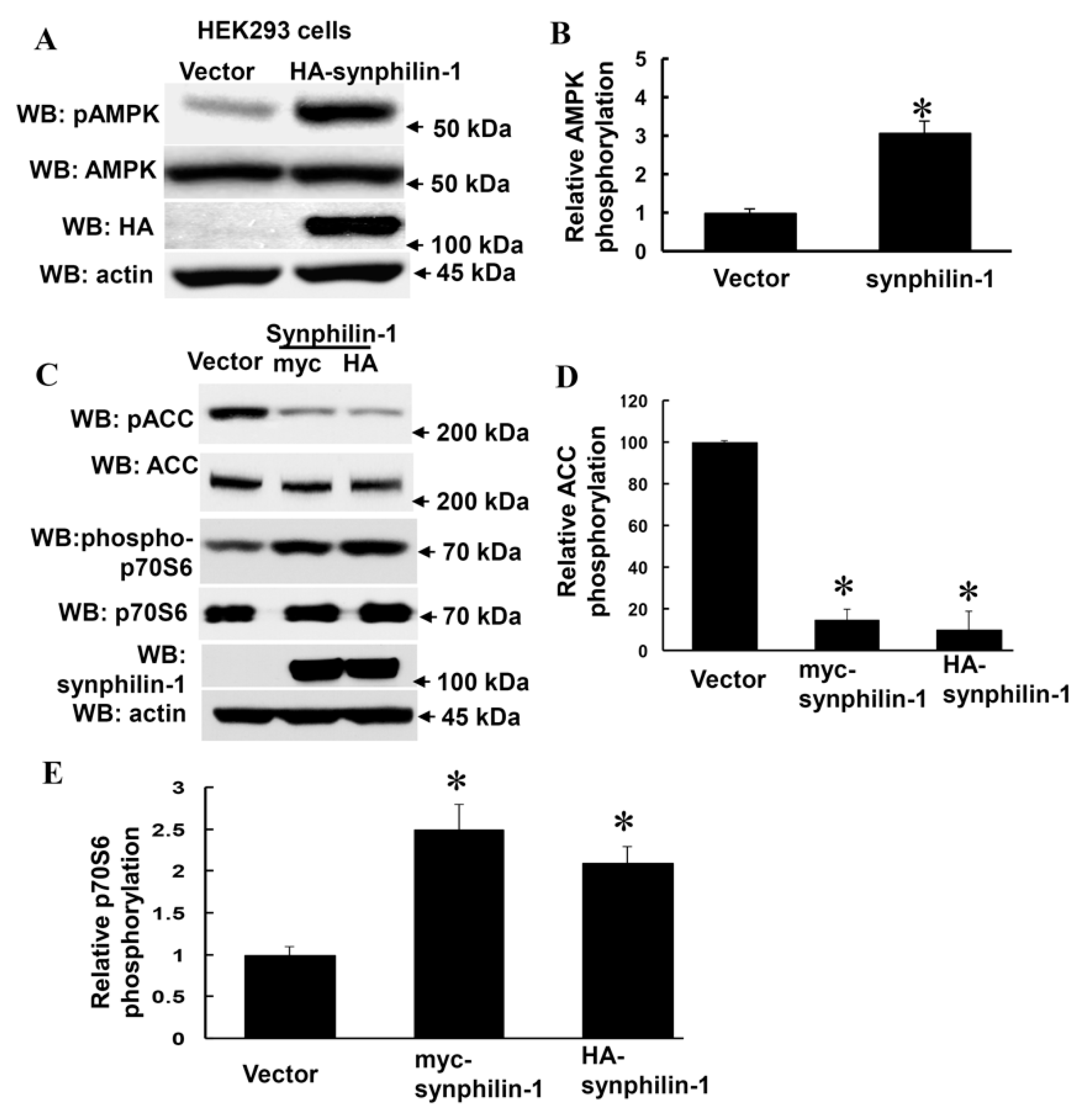
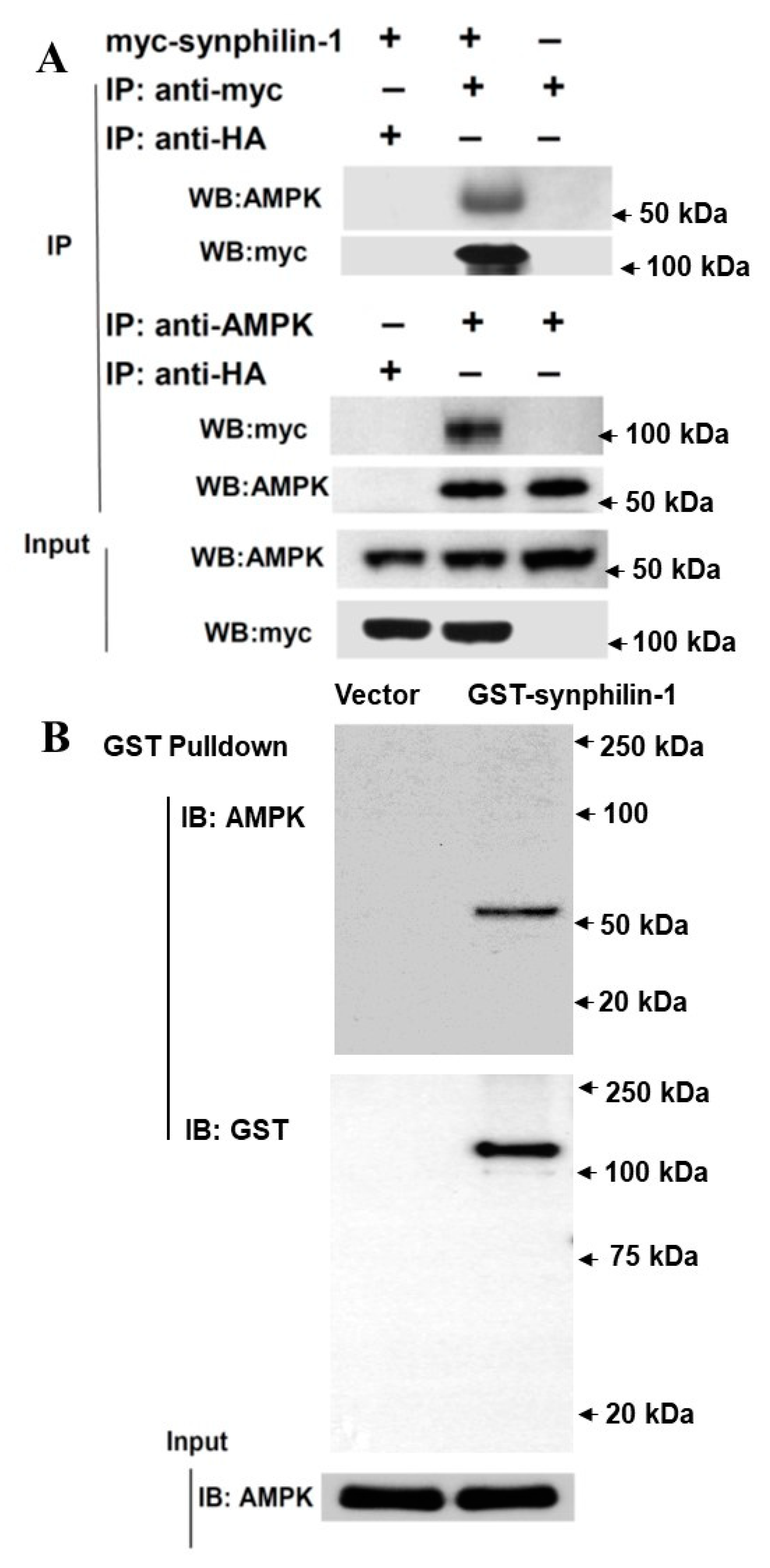
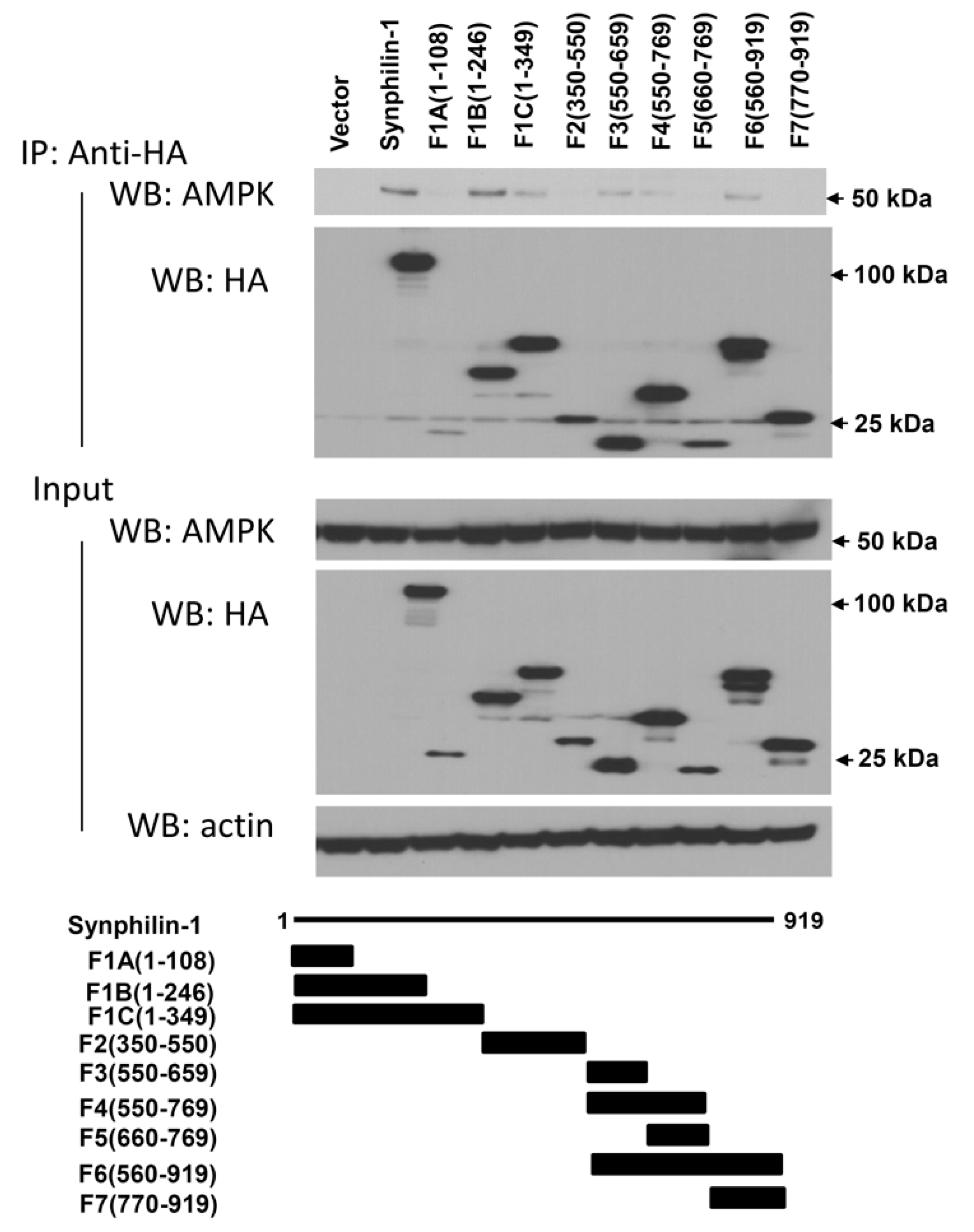
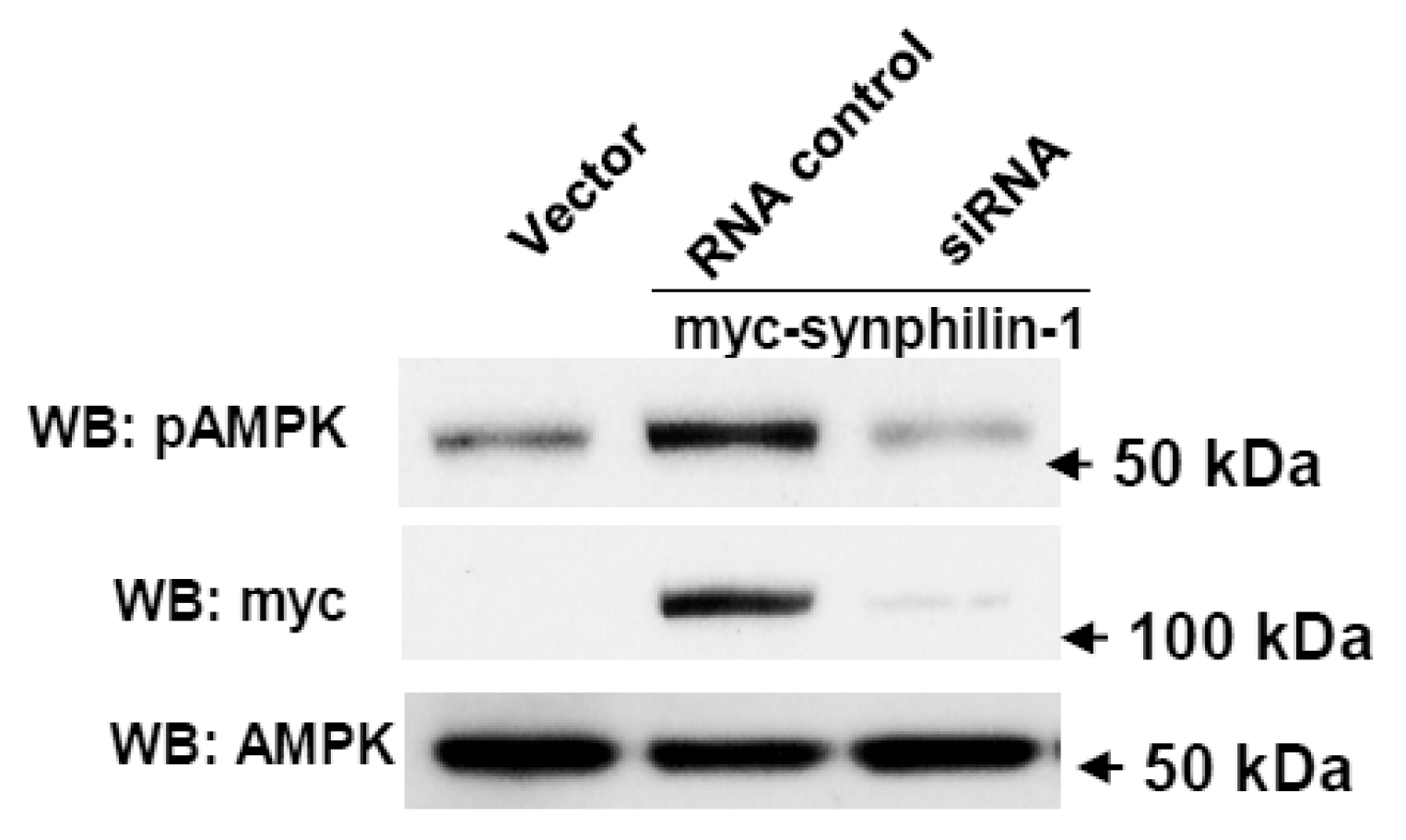
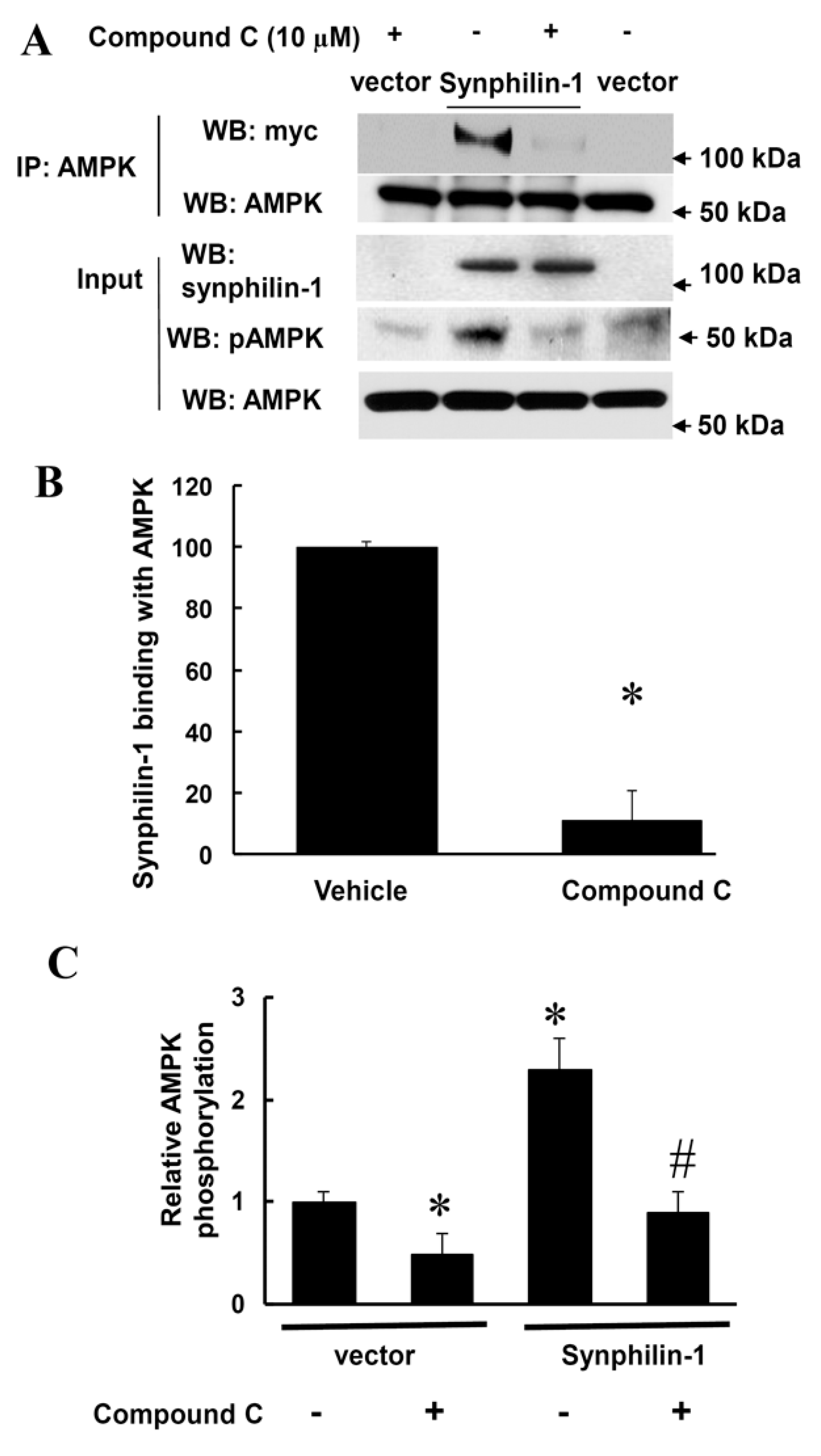
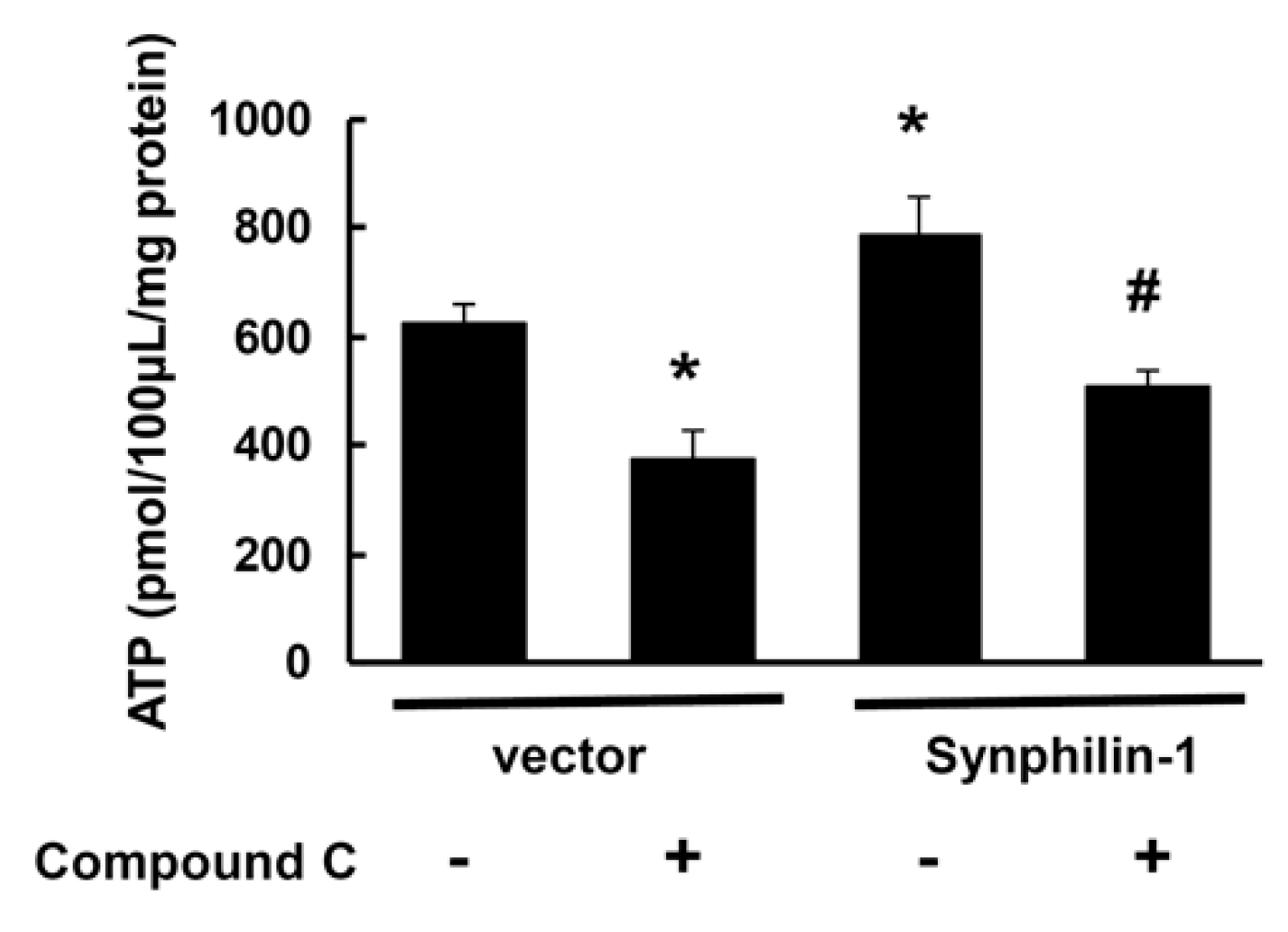
© 2020 by the authors. Licensee MDPI, Basel, Switzerland. This article is an open access article distributed under the terms and conditions of the Creative Commons Attribution (CC BY) license (http://creativecommons.org/licenses/by/4.0/).
Share and Cite
Li, T.; Liu, J.; Guo, G.; Ning, B.; Li, X.; Zhu, G.; Yang, D.; Moran, T.H.; Smith, W.W. Synphilin-1 Interacts with AMPK and Increases AMPK Phosphorylation. Int. J. Mol. Sci. 2020, 21, 4352. https://doi.org/10.3390/ijms21124352
Li T, Liu J, Guo G, Ning B, Li X, Zhu G, Yang D, Moran TH, Smith WW. Synphilin-1 Interacts with AMPK and Increases AMPK Phosphorylation. International Journal of Molecular Sciences. 2020; 21(12):4352. https://doi.org/10.3390/ijms21124352
Chicago/Turabian StyleLi, Tianxia, Jingnan Liu, Gongbo Guo, Bo Ning, Xueping Li, Guangjing Zhu, Dejun Yang, Timothy H. Moran, and Wanli W. Smith. 2020. "Synphilin-1 Interacts with AMPK and Increases AMPK Phosphorylation" International Journal of Molecular Sciences 21, no. 12: 4352. https://doi.org/10.3390/ijms21124352
APA StyleLi, T., Liu, J., Guo, G., Ning, B., Li, X., Zhu, G., Yang, D., Moran, T. H., & Smith, W. W. (2020). Synphilin-1 Interacts with AMPK and Increases AMPK Phosphorylation. International Journal of Molecular Sciences, 21(12), 4352. https://doi.org/10.3390/ijms21124352






